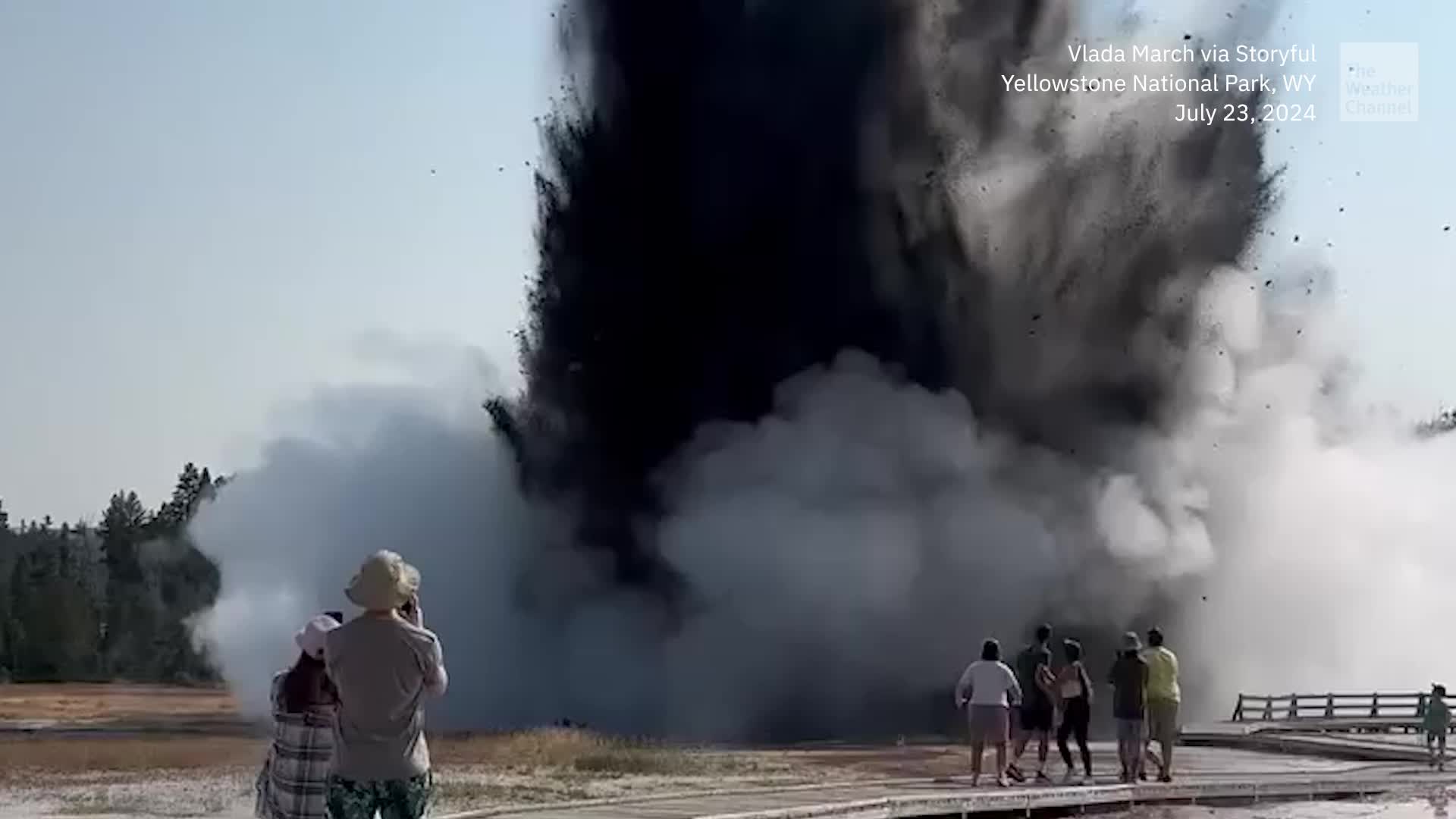Unexpected Hydrothermal Explosion in Yellowstone National Park Sends Visitors Fleeing!
CHEYENNE, Wyo. — On Tuesday morning, a sudden hydrothermal explosion in Yellowstone National Park ejected steam, water, and dark-colored rock and dirt high into the sky, causing sightseers to run for safety. The eruption, which occurred around 10 a.m. in Biscuit Basin, a hot spring area located a few miles north of the iconic Old Faithful Geyser, temporarily closed the area for visitor safety.

Dramatic Scenes Captured on Video
Videos posted online captured the dramatic scene as a couple dozen people watched from a boardwalk. As the eruption began to spray and grow, onlookers shouted warnings like “Back up!” and “Holy cow!” before running to avoid falling debris. The event unfolded under a massive cloud of steam, creating a stunning yet hazardous spectacle.
No injuries were reported, but the explosion caused significant damage to the boardwalk that protects visitors from Yellowstone’s fragile and dangerous geothermal areas. Vlada March, a California real estate agent who was on a tour in the basin with her family, described the moment her guide alerted them to the unusual activity.
“We saw more steam coming up and within seconds it became this huge thing,” March recounted. “It just exploded and became like a black cloud that covered the sun.” March’s quick thinking and swift action helped her family avoid injury, although rocks that fell from the sky smashed the boardwalk they had been walking on. Her mother, who was sitting near the explosion, was shaken but unharmed.
Investigating the Cause
The explosion likely resulted from a clogged passageway in the extensive natural plumbing network that underlies Yellowstone’s geysers, hot springs, and other thermal features, explained Mike Poland, Scientist-in-Charge at the U.S. Geological Survey’s Yellowstone Volcano Observatory. The clog caused a buildup of heat and pressure, similar to a pressure cooker, until the water suddenly flashed to steam, triggering the explosive event.
Poland estimated that the eruption sent material about 100 feet (30 meters) into the air and described it as “on the big side” of eruptions that occur periodically. While this explosion was significant, it pales in comparison to the largest known hydrothermal explosion in Yellowstone, which created a crater 1.5 miles (2.4 kilometers) across around 13,800 years ago in the Mary Bay area.
Past and Future Risks
Hydrothermal explosions are not indicative of new volcanic activity within Yellowstone’s dormant volcanic system, which remains at normal levels according to the U.S. Geological Survey. Similar explosions have occurred in Biscuit Basin in 2009, 1991, and after the magnitude 7.2 Hebgen Lake earthquake in 1959. Hydrothermal explosions like these are relatively common in Yellowstone, although they usually occur when no one is around.
Despite their rarity on a human timescale, large hydrothermal explosions pose a significant potential hazard. A 2018 report by the U.S. Geological Survey indicated that large hydrothermal explosions, capable of creating craters at least 328 feet wide, might be expected every few hundred years. The report identified at least 25 such craters in the park.
Immediate Aftermath and Safety Measures
Following the explosion, the Biscuit Basin area, including its parking lot and boardwalks, was closed for safety. Photos and videos of the aftermath showed damaged guardrails and boards covered in rock and silt near muddy pools. An aerial photo from the National Park Service showed that the Black Diamond Pool, the basin’s widest thermal feature, had somewhat enlarged and turned a muddy beige, while the nearby Sapphire Pool retained its usual blue hues.
Park geologists are investigating the specifics of the eruption. Mike Poland emphasized that the event serves as a reminder of the underappreciated hazards present in Yellowstone. Visitors are consistently warned to stay on boardwalks and trails in thermal areas, where the ground can be fragile, covering scalding and sometimes acidic water.
Historical Context and Visitor Safety
Yellowstone National Park, covering 3,471 square miles (9,000 square kilometers), is centered on a massive dormant volcano. Since 1890, at least 22 people have died from injuries related to thermal features in the park. The National Park Service continuously advises visitors to adhere to safety guidelines to avoid such dangers.
Hydrothermal explosions often send boiling water, steam, mud, and rock into the air, with heights potentially reaching up to 1.2 miles. The Black Diamond Pool, the site of Tuesday’s explosion, has a history of such activity, including an eruption following an earthquake in July 2006. Its average temperature is 148.5 degrees Fahrenheit.
Conclusion
While the hydrothermal explosion in Biscuit Basin was a dramatic and hazardous event, it was relatively small in the context of Yellowstone’s geothermal activity. The park remains a place of incredible natural beauty and scientific interest, but also one that demands respect for its powerful and sometimes unpredictable geothermal forces. Visitors are urged to stay informed and vigilant, following all safety guidelines to ensure a safe and enjoyable experience in this unique and dynamic environment.
As Yellowstone National Park geologists continue their investigation, the Yellowstone Volcano Observatory will provide updates as more information becomes available. This event highlights the importance of understanding and respecting the natural hazards that are part of the park’s awe-inspiring landscape.
